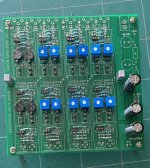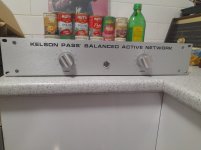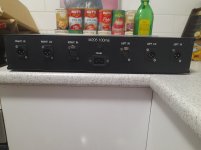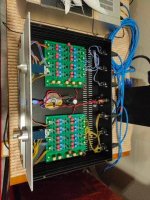Today it was a rainy day here in Switzerland, perfect to solder the B1 buffer and to do the body work. It is the same enclosure I used for my ACA mini.


@ Nelson
I have recently acquire the PAP Coax 10 Loudspeakers together with the PAP-C1 active crossover (said to be similar to B5). The PAP-C1 is a low pass and high pass xo but the PAP Coax 10 is a three way speaker, so i need another XO to act as bandpass and high pass. I am building the Biamp 6-24 for the bandpass and high pass portion. This will be fed by the high pass output of the PAP-C1. I am thinking of by passing the input buffer stage of the 6-24 and also the output cap of the C-1, so that the output buffer from the C-1 can feed the 6-24 directly. Please see the attached schematics to see if it would work, or i need to modify it.

I have recently acquire the PAP Coax 10 Loudspeakers together with the PAP-C1 active crossover (said to be similar to B5). The PAP-C1 is a low pass and high pass xo but the PAP Coax 10 is a three way speaker, so i need another XO to act as bandpass and high pass. I am building the Biamp 6-24 for the bandpass and high pass portion. This will be fed by the high pass output of the PAP-C1. I am thinking of by passing the input buffer stage of the 6-24 and also the output cap of the C-1, so that the output buffer from the C-1 can feed the 6-24 directly. Please see the attached schematics to see if it would work, or i need to modify it.
If you remove the buffer but leave the input pot, then the setting of the pot will influence of the filter that follows as its output impedance becomes part of the filter. You can reduce this effect by reducing the value of the pot to 25k.
I am retaining the pot into each of the high and low pass filter because I need to be able to control their level to match the drivers.If you remove the buffer but leave the input pot, then the setting of the pot will influence of the filter that follows as its output impedance becomes part of the filter. You can reduce this effect by reducing the value of the pot to 25k.
I assume the response can be shaped to compensate for baffle step loss? I've just started to read and scan the thread for the first time and haven't come across any BSC comments yet. Hope you can help. Exciting stuff!
do you really hear a difference between the TKD and the ALPS , worth the gap price ?🙂Just thought I would share some pics of my fully balanced network. I am waiting for the TKD pots to come back in stock so forgive the temporary alps blues.
View attachment 1048256View attachment 1048255View attachment 1048254
If one would like to have the musically optimized crossover would it be necessary to also replace the filter capacitors? Let’s say from wima to ClarityCap MR For example. Or changing these passive components would not make audible difference.
While I don’t spend a lot of energy on passives, I do like the Wimas and have used them a lot. Clarity caps also, but they are much larger and more $$.


I am making a non adjustable 24db xover with the boards at ~80hz. What is the downside, if any of using .01/.02 uf caps with 140k/280k resistors? Any thoughts?
No issues with film caps. As the impedance goes higher, you becomes more susceptible to noise issues, but I use values that high routinely.
If one would like to have the musically optimized crossover would it be necessary to also replace the filter capacitors? Let’s say from wima to ClarityCap MR For example. Or changing these passive components would not make audible difference.
Ref Musical: I have some experience with these crossovers and your best bet is a Wima PP 63 volt or 100 volt that will fit the pcb. The esteemed Douglas Self has solid THD measurements in film capacitors used in active crossovers. See Self's Active Crossover Design Book. The soothing H2 of these simple buffers will satisfy your musical enjoyment.
The low pass section won't be a problem due to the small gain bandwidth. I would keep it under 100K. 100K has significantly higher Johnson noise than 10K. Check the load and how much margin you have with the single ended bias current. Radiated noise or induced hum will be the most obvious issue with values over 100K.I am making a non adjustable 24db xover with the boards at ~80hz. What is the downside, if any of using .01/.02 uf caps with 140k/280k resistors? Any thoughts?
Pictures of my actual build, dedicated for my "big" setup in the living room, replacing a miniDSP 2x4HD


- Home
- Amplifiers
- Pass Labs
- DIY biamp 6-24 crossover




